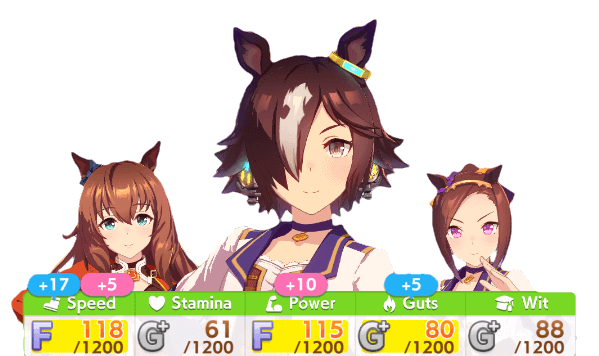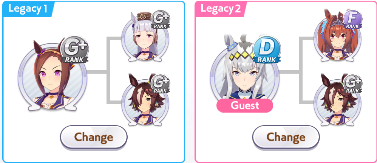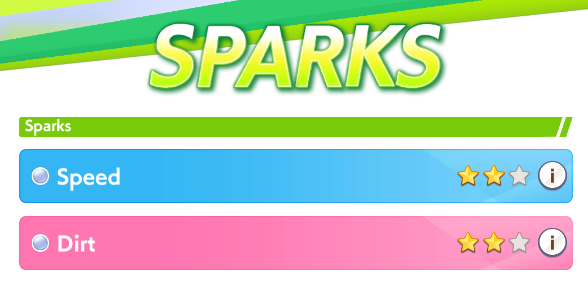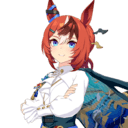Uma Musume Legacies

The Legacy (sometimes called inheritance) mechanic is one of the most important ones when it comes to training your horsegirls. Understanding it properly is important if you want to be successful in character building. This article aims to cover all the information about legacies, inspiration and sparks.
Table of Contents
Basics
Before you start any training, the game will ask you to choose two characters that will serve as Legacies (colloquially parents) of your trainee. Any of the characters you've previously trained can be selected for this, except for the trained uma herself (a girl can't be inspired by her own achievements from a past Career).

Legacies of those legacies will also be shown here. We'll call her the trained character's sub-legacies (colloquially grandparents), and they will affect inspiration bonuses as well. A girl can't be her own legacy, but she can be her own sub-legacy (let's just accept this fact).
Initial bonus
When you choose the legacies, several bonuses will be immediately applied to the character. These are determined by the legacies' and sub-legacies' sparks, which will be discussed later.

The first of them is a bonus to stats. Blue numbers come from the left legacy's lineage, pink numbers refer to the right legacy.
The second bonus improves the character's aptitude in track type, track length, or racing strategy. In the previous picture, you can notice several values being highlighted in yellow - these are aptitudes improved by legacies.
Inspiration events
Inspiration events happen twice every training, during the first half of April in years 2 and 3. They will start with a short cutscene where the character you're training runs after her legacies. After the cutscene ends, you will receive additional bonuses that depend on the sparks of the girl's legacies and sub-legacies.
You will always get extra stats, which depend on the blue sparks of the legacies and sub-legacies. The number of stars they have in these sparks will directly affect the stats received.
You can also randomly be inspired by green, white, or pink sparks (the different types of sparks are explained below in the sparks section). The chance of being inspired is affected by the overall compatibility of the character (triangle, circle, or double circle).
Character compatibility
After selecting legacies, you will probably notice a new symbol in the top right of the screen - that's compatibility. It has three tiers, ranging from worst to best - triangle, circle, and two circles (double O). However, the actual compatibility is a hidden number, and the symbols only represent a general range.
Compatibility will affect the bonuses you get in inspiration events, so having at least good compatibility is always a good idea. How is it calculated will be explained in the advanced section, but in general, it's usually a good bet to use girls with the same track length affinity (e.g. both legacy and trainee having A in Middle distance).
| Symbol | Meaning |
|---|---|
| ◎ | Great compatibility |
| 〇 | Good compatibility |
| △ | Poor compatibility |
Sparks
Sparks are a set of attributes generated for every character at the end of their Career. They affect what stats, aptitudes, and skills will the girl be able to pass on to a trainee when she's selected as their legacy.
When you finish a Career, at the very end you'll see a screen similar to the picture below.

Every spark will have either one, two, or three stars. Every character is guaranteed to get one blue spark and one pink spark, while green and white spark have more specific conditions. Let's have a look at all of the types.
Blue spark

Blue sparks give extra stats to the trainee and are arguably the most important sparks in general situations (and the most desired ones). Every character will get exactly one blue spark at the end of the Career.
| Japanese name | English name |
|---|---|
| スピード | Speed |
| スタミナ | Stamina |
| パワー | Power |
| 根性 | Guts |
| 賢さ | Wit |
What blue spark you'll get is calculated this way:
- The type (Speed, Stamina, etc.) is chosen at random.
- Then, your final value of that stat is checked.
- If it's less than 600: 90% for 1☆, 10% for 2☆
- If it's 600-1100: 50% for 1☆, 45% for 2☆, 5% for 3☆
- If it's over 1100: 20% for 1☆, 70% for 2☆, 10% for 3☆
At the start of a Career, blue spark from the legacies and sub-legacies will be added to the new trainee's stats as a bonus.
| ☆ | Stat bonus |
|---|---|
| 1☆ | +5 |
| 2☆ | +12 |
| 3☆ | +21 |
This bonus is additive for every legacy and sub-legacy. For example, if one of the legacies has 3☆ in speed, the other legacy has 2☆ in speed, and all four sub-legacies have 1☆ in speed, the total bonus to speed will be 21+12+5+5+5+5 = 53.
Pink spark

Pink sparks improve either track type aptitude, track length aptitude, or race strategy aptitude. Every girl will get one pink spark, and it will be randomly chosen from one of the three categories. Also, the rolled spark will always be something actually preferred by the character - for example, if a girl has a G rating in turf, it will never show up.
| Japanese name | English name |
|---|---|
| 芝 | Turf |
| ダート | Dirt |
| 短距離 | Sprint |
| マイル | Mile |
| 中距離 | Middle distance |
| 長距離 | Long distance |
| 逃げ | Front Runner |
| 先行 | Pace Chaser |
| 差し | Late Surger |
| 追込 | End Closer |
Like blue sparks, pink sparks can also give a bonus before the Career starts. For example, Haru Urara has a B rating in mile racing, but with legacies, this can get improved to A at the beginning. You can also roll a pink spark randomly during an inspiration event, and it can increase the aptitude even further - from A to S.
The number of stars you get at the end of a Career seems to be completely random. A horsegirl losing at the first possible opportunity without doing any training at all can still get 3☆ on her pink spark.
Green spark

Green sparks are a special type of spark that can grant trainees access to their legacies' unique skills. Unique skills are those with special animation and a rainbow background in the skill list (for example Maruzensky's LP1211-M).
The green sparks will only appear if the legacy's rarity is at least 3☆ at the start of the Career, and it's guaranteed. 1☆ and 2☆ won't get them, but you can eventually raise their rarity with character pieces.
Green sparks from legacies will always be obtained at the start of training. You can also roll it again during an inspiration event, in which case you'll receive a discount for the skill (if you haven't purchased it yet). You can also get sub-legacies' green sparks in inspiration events.
White spark

White sparks come in two variants - let's call them skill sparks and race sparks.
Skill sparks are pretty straightforward - they represent one of the trainee's normal rarity skills. You have a chance to get one or more skill sparks randomly at the end of a Career. If you obtain one of these during an inspiration event, the skill will become available with a discount (that will depend on the ☆ of the spark).
You have a chance to get race sparks from winning G1 races - it's still random, but you finally can directly affect the RNG, because you have to win a race to have a chance at getting one.
Functionally, they are similar to skill sparks. The difference is that they will grant two bonuses if you obtain them through inspiration - usually a skill hint and a small boost to one stat, or a small boost to two different types of a stat.
Unlike the previous types of sparks, there is a huge amount of race sparks, so they are listed on a separate page.
Careers also have their own sparks, which are similar to race sparks.

At the end of a Career, every normal rarity skill, victorious G1 race, and the Career itself have 20% chance of generating a white spark. ◎ skills have 25% chance, and rare (gold) skills have 40%.
The chance for 1☆ is 50%, for 2☆ 45%, and for 3☆ 5%. The chances for 2☆ and 3☆ increase if the umamusume is at least SS rank.
Advanced
If you've read everything so far and started thinking that it's mostly just pure randomness, then... You wouldn't be wrong. Getting a girl with desirable sparks and high stars on them is a pain and you'll be at the mercy of the dice often. However, proper knowledge of the mechanics will significantly help you fight the unyielding tides of RNG.
What to aim for
When you're starting out, almost any combination of characters that's not downright horrible will do. However, if you keep playing the game past the honeymoon period, you'll probably want to build a powerful legacy of horsegirls.
Blue sparks are often regarded as the most important ones because the amount of stats you can get from them over the course of the training is very significant (more so when your support card pool isn't that great yet). Of course, in an ideal world, you'd have 3☆ sparks across the board, but don't expect an ideal world when farming legacies. So focusing on getting 3☆ blue sparks is a good start.
Stamina and Power are the most popular blue sparks. Speed is almost always heavily focused during Career training and doesn't need the extra help, while Guts and Wit are often just not as valuable.
Your end goal, for now, should be having a 3☆ blue spark Veteran character whose legacies both also have a 3☆ blue spark. If you've ever heard some saying that they want a "9*", it's referring to this. 9* Veterans give the highest possible amount of stats (63 at the start and a lot more during the inspiration events), so having one of these will make further training much smoother. Or, well, two of these, preferably.
When it comes to pink sparks, length-based ones are what you usually want. Getting an S rank aptitude in your distance type during an inspiration event is great because it gives a lot of raw speed.
Surface-based pink sparks are pretty good too - they're not as game-changing as length sparks, but they're more "universal", because there are only two of them, compared to four length sparks.
Strategy-based sparks are usually not as good, but they are still useful if you need to do a Career for a trainee with a strategy she doesn't inherently excel in.
For white sparks, the URA Scenario spark from winning the URA Finale is the most desirable one. After that, generally just aim for quantity (by having lots of skill and winning lots of G1 races).
Borrowing friend characters (Guest legacies)
Don't forget (because a lot of people do) that you can borrow Veterans from your follow list as legacies. If you can follow someone with a desired 3☆ blue spark, and get one yourself, you can use them together as legacies to try and go for a 9☆ girl.
Yes, you can only try that three times per day, but, well, this is a gacha game, so you're probably used to stuff like that.
Spark farming
Eventually, after playing the game for a while, you might want to target specific sparks on specific umas for legacy purposes. For example, your goal could be something like Mejiro Ryan with three medium distance sparks and full 9☆ stamina (or power).
Farming specific builds like this will never be exactly easy, but you can still streamline the experience a little bit.
First, as mentioned in the previous section, always use borrowed Veterans when possible. To do a "full" build, you'd need to train two legacies before doing a Career with the desired trainee herself. By finding an ideal guest legacy, a third of the work is already done - and it will most likely be a better build than someone you'd train yourself.
Another important thing is having 600+ (preferably 1100+) in the stat you want to get a blue spark of - and if you don't exactly care which blue spark you get (as long as it's 3☆), it's even easier. Just make sure you have 600 stats across the board, and hope for a high roll. Also, you need enough stats to actually win the Career, which might vary from uma to uma!
After you're satisfied with the stats, you can focus on racing (preferably G1). Not only does this give you a chance at rolling (hopefully multiple) race sparks, but it will also increase the final compatibility bonus (as explained in the compatibility calculator).
Because your stats don't need to be perfect during spark farming runs, you can also change your support card setup a bit. Maybe include a card with interesting skill hints, because if you buy the skill and get it as a white spark, it will make the Veteran even more valuable as a legacy.
Getting double O compatibility
In the Basics section, we talked about compatibility affecting inspiration events. But how is it calculated?
Every pair of characters in the game has a set compatibility rating, and the higher it is, the better their compatibility will be. When you select the legacies for a trainee, the game will crunch several numbers together (the exact process is described in detail on the compatibility calculator page).
If the final number reaches the first threshold, the total compatibility will be single O. If it reaches the second threshold, it will be double O.
In general, characters will similar affinities will usually have good compatibility - so if you're doing a Career for a long-distance specialist, her legacies (and sub-legacies too, if possible) should specialize in long distance as well. This is just a rule of thumb, but it will apply in most situations.
If you want concrete numbers, go check out the compatibility calculator!
Legacy loop
Note: The rest of the article will describe a strategy that was very popular around the JP server release, but mostly fell out of favor ever since. It's left here for historical reasons and you might still learn something from it, but there's no need to do this.
Legacy loop (or Inheritance loop, or Breeding loop) refers to the strategy of finding several (usually four) characters with high compatibility and then repeatedly using them as legacies for each other (without using any other characters) until you reach satisfying builds on all of them.
Why use loops?
Actually, you most likely don't want to. This is a rather outdated strategy, but because it's still often discussed, I'll leave the description here.
Let's get a little bit philosophical first. There are two types of "good" Careers you can reach in Uma Musume.
The first one is, obviously, getting a horsegirl with amazing stats and skills. You can then use her to compete in PvP and other game modes outside of Careers. This one goes without saying.
The second one would be characters that manage to get desired sparks at the end of the Career. In that case, it doesn't matter if you failed the run before finals with terrible stats.
If you raise characters at random, chances are you will end up with amazing sparks eventually... on two incompatible characters. Loops try putting everything into one package. You pick four characters with high compatibility, and only rotate those four.
The problem is, loops are kind of mind-numbing, long, and don't actually increase the chances of getting good factors. So you might as well play the game normally and get a variety of usable characters.
Loop example
Most guides tend to demonstrate the loop as a tree, however, some people have a problem visualizing it that way. Let's try using a simpler way to understand the process.
We're gonna use the well-known combo of Vodka, Daiwa Scarlet, Grass Wonder, and El Condor Pasa. Imagine the four characters in a list, ordered A to D. In the first round, A and B (Vodka and Daiwa) will be the legacies, while C (Grass Wonder) will be the trainee.
| ↓ Legacy ↓ | ↓ Legacy ↓ | ↓ Trainee ↓ | |
After the first round, we'll move all the markers one position to the right. So B and C (Daiwa and Grass Wonder) will be the legacies, and D (Condor) will be the trainee. Remember to use the version of Grass Wonder that you trained in the previous step.
| ↓ Legacy ↓ | ↓ Legacy ↓ | ↓ Trainee ↓ | |
After that, we're gonna continue moving the markers to the right. Because we're at the end of the list, simply loop back to the beginning.
| ↓ Trainee ↓ | ↓ Legacy ↓ | ↓ Legacy ↓ | |
Moving to the right once again.
| ↓ Legacy ↓ | ↓ Trainee ↓ | ↓ Legacy ↓ | |
And when you move right after the fourth step, you'll notice that you have looped all the way back to the beginning. There you have it, a legacy loop!
After you've successfully looped twice, you don't have to keep using the characters trained in a previous step. Use the strongest version you've gotten so far. After all, that's the main point of using loops - continuously making your lineage stronger.
When you reach the land of constant double Os, you also don't have to shuffle the trainee/legacy setup all the time. Feel free to do Careers for one character with the same legacies until you get whatever sparks you want. After that, just move on to the next step.






